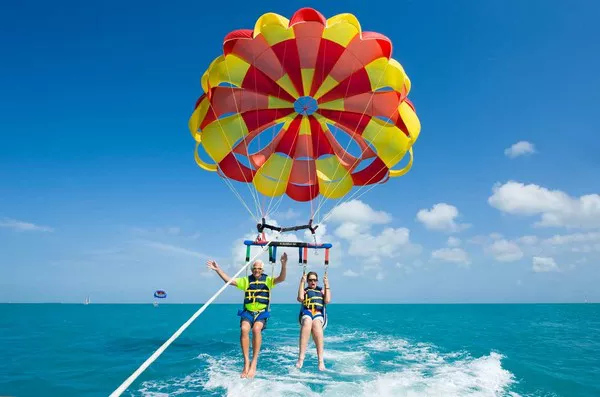Parasailing is an exhilarating water sport that allows individuals to glide through the air while being towed behind a boat. With the wind in your hair and the vast expanse of the sky above, parasailing offers a unique perspective and an unforgettable experience. However, before taking to the skies, it’s essential to understand the equipment, safety procedures, and techniques involved in this thrilling activity.
Understanding the Basics: Equipment and Gear
Before embarking on a parasailing adventure, it’s crucial to familiarize yourself with the essential equipment required for a safe and enjoyable experience. The primary components of parasailing equipment include:
1. Parasail Canopy: The parasail canopy, also known as the sail or chute, is the large, triangular-shaped fabric that catches the wind and lifts the participant into the air. Canopies come in various sizes, with larger canopies providing more lift and allowing for higher flights.
2. Harness: The harness is a vital piece of equipment that connects the participant to the parasail canopy. It’s essential to ensure that the harness fits snugly and securely to prevent any discomfort or risk of slipping during the flight.
3. Tow Rope: The tow rope is the line that connects the parasail canopy to the boat. It is typically made of durable, high-strength materials capable of withstanding the forces exerted during the flight. The length of the tow rope can vary depending on factors such as wind conditions and the desired height of the flight.
4. Boat: The boat serves as the towing vehicle for the parasail. It’s essential to use a sturdy and reliable boat operated by experienced professionals to ensure a safe and enjoyable parasailing experience.
Safety Equipment: In addition to the primary parasailing equipment, it’s crucial to have appropriate safety gear on board, including life jackets, helmets, and communication devices.
Pre-Flight Preparation: Safety Procedures and Guidelines
Before taking off on a parasailing adventure, it’s essential to undergo thorough pre-flight preparation to ensure the safety of all participants. This includes:
1. Safety Briefing: Prior to boarding the boat, participants should receive a comprehensive safety briefing from trained professionals. This briefing should cover essential topics such as proper harnessing techniques, hand signals for communication during the flight, and emergency procedures.
2. Weather Assessment: Parasailing should only be attempted in suitable weather conditions. Wind speed, direction, and potential weather hazards should be carefully assessed before launching the parasail. It’s essential to avoid parasailing in strong winds, thunderstorms, or other adverse weather conditions that could compromise safety.
3. Equipment Check: Before boarding the boat, participants should inspect all parasailing equipment to ensure that it is in good working condition. This includes checking the harness for any signs of wear or damage, inspecting the tow rope for fraying or knots, and verifying that the parasail canopy is securely attached to the harness.
4. Communication: Clear communication between the participant and the boat crew is essential for a safe parasailing experience. Participants should familiarize themselves with hand signals used to communicate with the boat crew during the flight, including signals for speed adjustments, landing instructions, and emergency situations.
Taking Flight: Techniques for a Smooth Ride
Once all safety procedures have been followed, and the equipment is in place, it’s time to take flight! Here are some techniques to ensure a smooth and enjoyable parasailing experience:
1. Proper Body Positioning: Maintaining the correct body position is crucial for stability and control during the flight. Participants should lean back slightly with their legs extended and their arms relaxed to minimize resistance against the wind.
2. Relax and Enjoy: Parasailing is a relatively passive activity, so it’s essential to relax and enjoy the experience. Avoid tensing up or gripping the harness too tightly, as this can lead to discomfort and fatigue.
3. Take in the View: One of the most incredible aspects of parasailing is the breathtaking view from high above. Take the time to appreciate the stunning scenery below and the sensation of flying through the air.
4. Communicate with the Boat Crew: Throughout the flight, maintain open communication with the boat crew using the pre-established hand signals. If you have any concerns or discomfort during the flight, don’t hesitate to signal the crew for assistance.
Landing Safely: Bringing the Adventure to a Close
As the parasailing adventure draws to a close, it’s essential to execute a safe and controlled landing. Here’s how to ensure a smooth landing:
1. Communication with the Boat Crew: As the boat slows down and prepares for landing, communicate with the boat crew to coordinate the descent. Use hand signals to indicate when you are ready to return to the boat and any adjustments needed for a safe landing.
2. Prepare for Landing: As the boat approaches the landing zone, prepare for touchdown by bending your knees slightly and bracing for impact. Keep your feet up to prevent them from making contact with the water during landing.
3. Assist with Landing: The boat crew will guide the parasail canopy towards the landing platform on the boat. Follow their instructions closely and be prepared to assist with the landing by using your feet to help steer and control the descent.
4. Secure Equipment: Once safely back on the boat, ensure that all parasailing equipment is properly stowed and secured for the return journey. This includes coiling the tow rope, folding the parasail canopy, and storing the harness in its designated location.
Conclusion
Parasailing offers an unparalleled opportunity to experience the thrill of flight and enjoy breathtaking views from high above. By following the proper safety procedures, familiarizing yourself with the equipment, and employing the techniques outlined in this guide, you can enjoy a safe and unforgettable parasailing adventure. So, gear up, take to the skies, and soar high with the wind beneath your wings!

